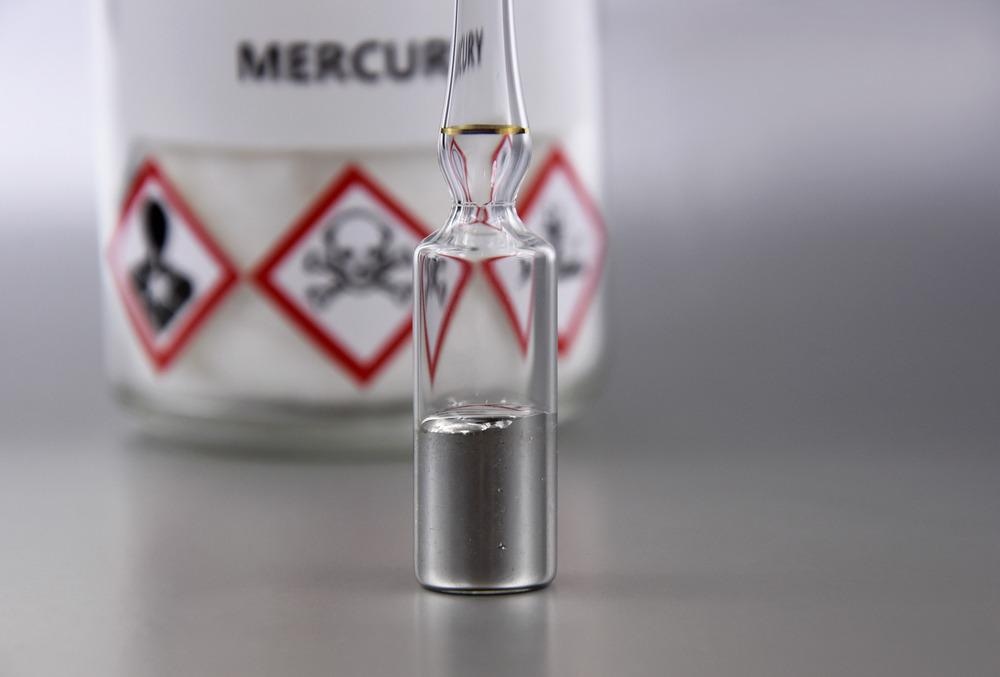An article published in the journal Scientific Reports investigated a potentially clean solution for storing mercury waste based on the containment of solid-state nanoscale mercury at room temperature (RT).

Study: Mercury goes Solid at room temperature at nanoscale and a potential Hg waste storage. Image Credit:BeataGFX/Shutterstock.com
The Unique Properties of Mercury
Mercury (Hg) is one of the most remarkable periodic metals when it comes to its physio-chemical characteristics at ambient temperatures. In particle physics, its increased density shortens the target's physical dimension and affects the construction of the pion capturing mechanism, the temporal distribution of the subsequent burst, and pion generation.
In astrophysics, it has been utilized as an effective infrared liquid reflector due to its liquid metal form and hence its greater surface smoothness paired with its excellent IR reflectance. Likewise, because of its strong infrared reflecting optical properties, it was a potential grazing incident reflector for laser-based inertial fusion energy studies.
How Does Mercury Crystallize at Room Temperature?
In the gaseous state, mercury is the only metal that will not make diatomic molecules. Its mass RT liquid characteristic is attributed to its uncommon gaseous structure.
At RT, mercury, being a singular liquid-state metal, has the greatest elemental surface tension. Mathematical simulations on the fluid–vapor junction of basic metals, as well as disturbance intensification up to the 2nd order in the surface "e-ion" pseudo-potential, have revealed that elevated surface tension might induce considerable surface atomic stacking of three to five atomic planes.
This surface atomic arrangement at ambient temperature found on the level surface of bulk mercury may be great, if not radically, increased in mercury nanoparticles (NPs) if they could be engineered. As such, the surface atomic density in nanoscale mercury would be higher due to its high surface-to-volume ratio and three-dimensional symmetric breakdown. Because of the greatly enhanced surface tension of mercury, surface processes will now outweigh gravitational influences at this scale.
The increased surface fraction of nanoscale mercury should result in an increase in Laplace surface tension. At ambient temperatures, this additional surface tension will cause a net crystallization of the nanoscale mercury from the liquid state to the solidified a-rhombohedral state. As a result, at ambient temperatures, this atomic arrangement event should express itself as a considerable crystallization from the liquid state to the crystalline rhombohedral-type state.
Key Findings of the Study
While bulk Hg is in the liquid phase at RT, in its nanoscale arrangement it exists in the solid phase. Mercury NPs integrated into a two-dimensional turbostratic boron nitride (BN) host framework displayed net crystallization at RT by combining the nanoscale size influence and the Laplace driven surface surplus tension.
Mercury NPs with a diameter less than the P–T phase diagram's predefined threshold of 2.5 nm demonstrate net crystallization expressing themselves via surface atomic stacking of roughly seven to eight atomic planes.
Nanoscale mercury exists in the solid phase at RT with an a-rhombohedral crystalline framework below such a predefined threshold of 2.5 nm. Mathematical simulation using various codes and estimations revealed a clear-cut buildup and reduction of electron charge concentration upon the adsorption of mercury atoms.
The variations in charge concentration are most apparent during the adsorption of Hg (101) and (003) surfaces. This latter finding lends credence to the experimentally measured atomic arrangement and solidification of nano-sized mercury at ambient temperatures.
From the standpoint of technical implementations, and in light of the conceptual and experimental findings acquired, the methodology adopted in this work represents a viable method of storing mercury at ambient temperatures.
The solid nature of nano-sized mercury reduces its vapor threat at RT, supporting the concept of safe storage. Given the vapor pressure of liquid-phase bulk mercury, integrating mercury in its nano-sized form in chemically unreactive BN frameworks could represent a substantial breakthrough in the safe storage of Mercury and the reduction of its dangerous aspects, particularly for mercury waste created from current halogen efficient light systems.
As a follow-up to this foundational work, synchrotron-based methods like EXAFS, SAXS, and powder XRD should be used.
Reference
Kana, N., Morad, R. et al. (2022). Mercury goes Solid at room temperature at nanoscale and a potential Hg waste storage. Scientific Reports, 12. Available at: https://doi.org/10.1038/s41598-022-06857-6
Disclaimer: The views expressed here are those of the author expressed in their private capacity and do not necessarily represent the views of AZoM.com Limited T/A AZoNetwork the owner and operator of this website. This disclaimer forms part of the Terms and conditions of use of this website.